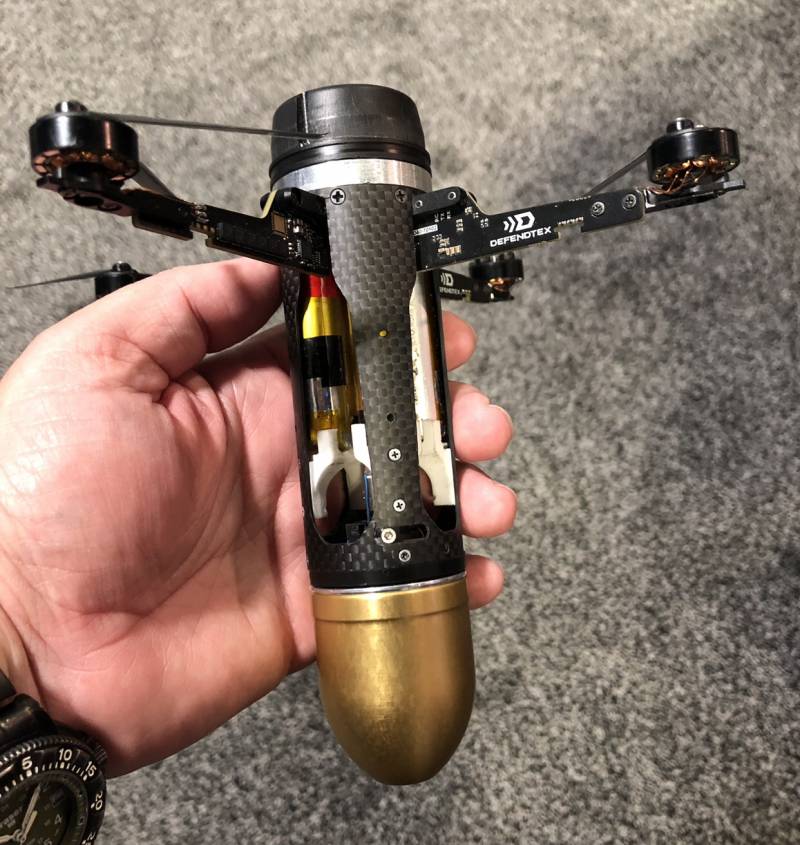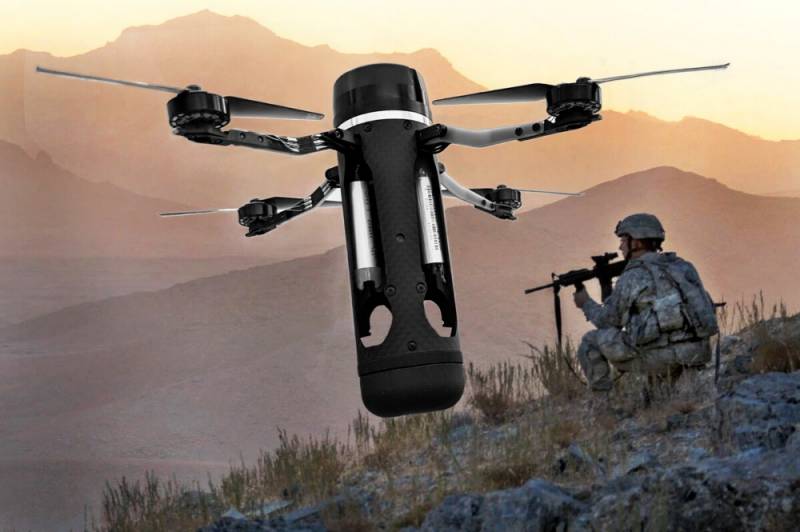DefendTex Drone-40 Barrage Ammunition: A Compact Multi-Purpose Tool
Original concept
DefendTex Drone-40 barrage munition was developed recently, it was first presented in May this year at the conference of the US Special Operations Forces SOFIC-2019. The military was familiarized with the new project documentation and with a real model.
The Australian company offers an original concept of a multifunctional product, on the basis of which you can create locking ammunition of different sizes and with different characteristics. The project Drone-40 is about the device caliber 40 mm, compatible with a number of existing grenade launchers.
A new type of UAV should be fired by a grenade launcher or other launcher, then launch its own propeller groups and fly. Using its own means of observation, the product provides target searching or reconnaissance. In another configuration, it is able to strike at the designated object. The concept provides for equipping the device with combat units of various types or specialized equipment.
According to the developer, such ideas can be implemented in locking ammunition of various kinds. Already submitted product for 40-mm systems. In the future, it is planned to develop similar systems in the form of an 12 caliber cartridge and 81-mm mines.
Drone-40
The current Drone-40 product is a device with a caliber of 40 mm and a length of about 170-180 mm with a cylindrical body and a lively or flat head fairing. Such a UAV is noticeably larger and heavier than the standard 40x46 mm grenade, but differs from it in functions and objectives.
The ammunition head is a payload module. First of all, the Drone-40 should carry combat units of various types. Declared the possibility of using fragmentation, armor-piercing, smoke or thermobaric warhead. It is also possible to use a reconnaissance system with a video camera or an “anti-thrust” warhead. The method of action of the latter is not specified.
The cylindrical part of the body is an instrument compartment with the necessary equipment. Four slots are provided in the housing wall, in which four folding supports with electric motors and screws are placed before launch. Inside the case are controls, battery, etc. The flight is carried out with the help of four motors with screws. The device is controlled from the console or flies according to a predetermined program using satellite navigation. The rear wall of the central compartment is reinforced for interaction with powder gases. This part of the Drone-40 is placed in a sleeve with a propellant charge.
Using any serial 40-mm grenade launcher, the Drone-40 product should be launched in the direction of the enemy. Available powder charge provides care from the starting point. In flight, the UAV opens the plumage and starts the engines, as a result of which it becomes a typical quadcopter. The on-board equipment provides two-way data exchange and video transmission to the operator.
The onboard battery allows the ammunition to fly an active flight for 12 minutes. When hovering at one point, the flight time increases to 20 min. Level flight speed - up to 20 m / s. Work is provided at a distance of up to 10 km from the operator.
It is argued that the system Drone-40 is extremely simple design and low cost. The drone consists mainly of finished components that are in the series. Especially for it is made the minimum required number of parts. Due to this, the cost of experimental products does not exceed $ 1000. The launch of mass production will reduce this parameter by about half.
Methods of Use
As planned by the creators, the Drone-40 munitions munitions can be used to solve a wide range of tasks by infantry or special units. First of all, such products should be a simple and affordable means of intelligence. With the help of standard weapons, the fighters will be able to “hang” a video camera over the enemy’s position and observe its actions, gaining an advantage.
According to the data from the reconnaissance vehicle, it is possible to carry out an attack using combat UAVs. To this end, DefendTex offers several options for combat units for various purposes. With their help, ammunition can fight manpower, buildings and even armored vehicles. Due to the ability to control and manual guidance, Drone-40 should show high accuracy and effectiveness of hitting targets.
It is also proposed the mass use of anti-ship ammunition with different payloads. Such a “swarm” should include devices with reconnaissance equipment and products with warheads of different types. This will allow you to explore and identify targets in a given area, and then hit them using the most effective in this situation. weapons - including a simultaneous strike.
Possible prospects
The theme of anti-ship ammunition in recent years has been actively developed, aided by both the development of technology and the interest from industry and potential customers. Australian experts from DefendTex drew attention to this trend and presented their concept, as well as one of the options for its implementation.
The Drone-40 sample shown in May looks interesting and promising, though not without flaws. No less interesting is the general concept of building a UAV in the form factor of ammunition for rifles, grenade launchers and mortars. It can be further developed and has chances to reach real operation.
The main advantage of the project DefendTex Drone-40 can be considered the fact of creating locking ammunition for 40-mm grenade launchers. Such a product does not require special means to launch, and therefore it can enter into service with a wide range of units. Low cost and its expected reduction will also contribute to the widespread adoption of the Drone-40. The ability to use different warheads or special equipment is also a definite plus tactical.
The use of the 40mm grenade form factor for infantry grenade launchers has led to limitations and even disadvantages. Due to the limited dimensions of the case, the Drone-40 can only be in the air for a maximum of 10-20 minutes. The carrying capacity of the product is limited, and therefore the video camera has to be made as a separate module for mounting instead of the warhead. Because of this, attacking one target using one warhead requires the participation of at least two drones.
Some of the problems that exist with the Drone-40 can be eliminated when developing new locking ammunition with increased dimensions. So, 81-mm mortar mine can simultaneously carry the camera and the warhead. In the case of smaller products, such as the “bullet” of an 12 caliber, new problems and difficulties should be expected.
It should be noted that at the moment DefendTex Drone-40 products exist only in the form of prototypes and still remain at the testing stage. The existence of the project was told only a few months ago. The new development has attracted media attention, but so far nothing is known about the interest of potential customers. Also, the timing of the emergence of new designs that develop the proposed concept remains unknown.
Thus, the interim results of the project so far look modest. Australian experts from DefendTex have proposed and implemented an interesting concept of a compact and lightweight patrol munition that can carry different loads and solve various problems. However, due to objective limitations, the Drone-40 product has some drawbacks that can impair its real capabilities. What will be the future of the new ammunition and the whole concept is unclear. You should expect new messages. Perhaps they will reveal both the future of the project and the opinion of potential customers.


Information